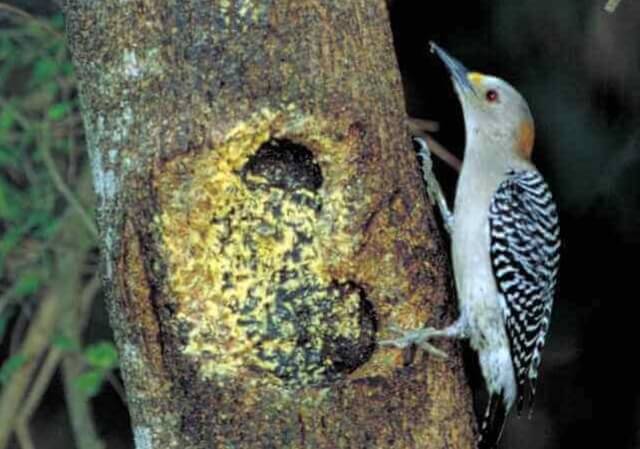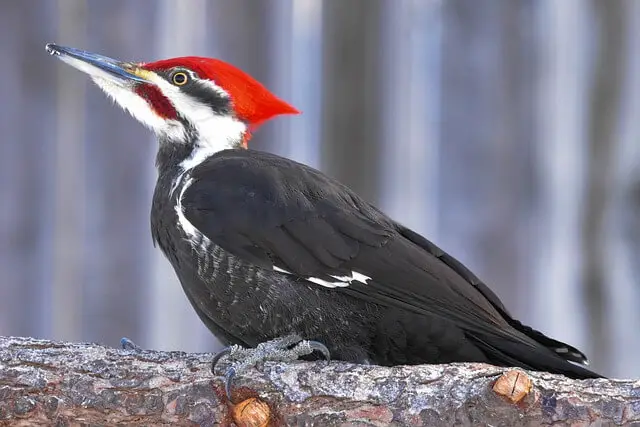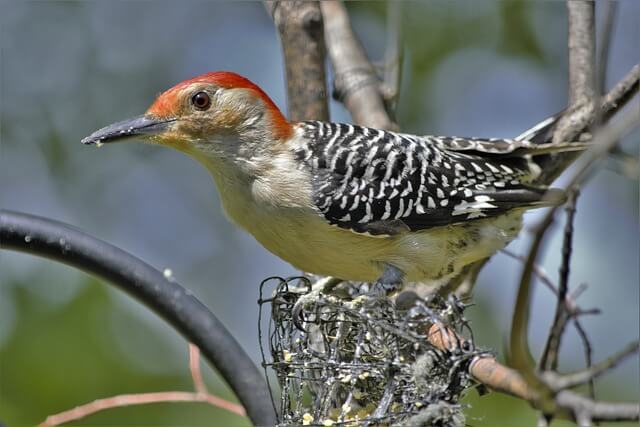Birdwatching enthusiasts often find joy in identifying various species, but some birds can look remarkably similar, leading to delightful challenges. The Red-headed Woodpecker, with its striking red head and bold black and white plumage, is a standout.
However, several other birds share similar features. In this guide, we’ll explore birds that look like Red-headed Woodpeckers, helping you distinguish these look-alikes and enhance your birdwatching skills. Let’s dive into the fascinating world of avian look-alikes!
Table of Contents
Birds That Look Like Red-headed Woodpeckers
Golden-fronted Woodpecker
- Length: 8.7-10.2 in (22-26 cm)
- Weight: 2.6-3.5 oz (73-99 g)
- Wingspan: 16.5-17.3 in (42-44 cm)
- Maps: Range Map – Sightings Map
- Sounds: Calls and Songs
- Scientific Name: Melanerpes aurifrons
The Golden-fronted Woodpecker is a large woodpecker found in the Southern States of the United States and Central America. They are distributed from South Texas to southern Mexico, Guatemala, Belize, Honduras, Nicaragua and Costa Rica.
Golden-fronted Woodpeckers prefer habitats near streams or rivers that have woodlands along their banks. These birds will also inhabit mesquite forests or tropical rainforests as well.
In addition to having these preferred habitats, they can inhabit dense, deciduous forests, or mature forests with plenty of dead trees for them to nest in, so they’re not usually found near people or in urban areas like red-headed woodpeckers.
It is easy to confuse them with Red-headed Woodpeckers, but they are more slender, and have a black and white barred back, while the red-headed woodpecker has a black back with white wingbars. The Golden-fronted Woodpecker also has bright yellow markings on its head that contrast well against its dark feathers.
They measure around 9 to 10 inches long with a wingspan of 17 inches, and a weight of (2 – 4 oz) 56-113 grams. Red-headed primarily feed on insects, fruit, seeds, occasional birds’ eggs and lizards.
Pileated Woodpecker
- Length: 15.8-19.3 in (40-49 cm)
- Weight: 8.8-12.3 oz (250-350 g)
- Wingspan: 26.0-29.5 in (66-75 cm)
- Maps: Range Map – Sightings Map
- Sounds: Calls and Songs
- Scientific Name: Dryocopus pileatus
The Pileated Woodpecker is found in Canada from southern Quebec through Ontario westward into Manitoba. It inhabits semi evergreen forests in eastern North America, the Great Lakes, the Northern forests of Canada, and some areas of the Pacific Coast.
The Pileated woodpecker’s diet consists mainly of insects such as ants, and beetles, but also includes other invertebrates like crickets or spiders. They have an average lifespan of 10 years in their natural habitat.
These birds are larger than red-headed woodpeckers, have white on the face and neck area, and have a large red crest on its head with a black stripe across the eyes, and a white line down the side. The male has an almost all black plumage with some white patches along on the wings, while females are browner.
The Pileated woodpecker’s call is described as “chuh chuh chuwah.” The pileated woodpecker is one of the largest birds in North America, with a length of 20 inches (51 cm) and a wingspan of about 32 inches (81 cm). They can weigh as much as 0.8 pounds (.36 kg), which makes them larger than red-headed woodpecker.
Related: How to Attract Pileated Woodpeckers to your Yard (Fast)
Red-bellied Woodpecker
- Length: 9.4 in (24 cm)
- Weight: 2.0-3.2 oz (56-91 g)
- Wingspan: 13.0-16.5 in (33-42 cm)
- Maps: Range Map – Sightings Map
- Sounds: Calls and Songs
- Scientific Name: Melanerpes carolinus
Red-bellied Woodpeckers are slightly smaller than the Red-headed Woodpecker, and they have a white face, while the red-headed has a red head. The backs of the Red-bellied woodpecker is black with white barred stripes on it, while the back of the Red-headed woodpecker has a black back with white wingbars.
The most notable difference between these two birds is that one has a white face and one has a red head. There are many differences between these two birds such as color, size, voice call etc. They are 9 to 11 inches in length, have a wingspan of 14 to 19 inches, and weigh from 55 to 90 grams.
They mainly eat insects, fruits, nuts, seeds, berries and tree sap. The red-bellied woodpecker is not native to North America, but can be found in Central America and Mexico. They have also been spotted throughout the United States East of the Rocky Mountains.
They also have a different call than the red-headed woodpecker, with the red-bellied woodpecker having a single chirp sound followed by four or five descending chips, while the red-headed has two to three rapid cheeps that end in a lower note. Red-bellies also nest in trees, while Red-heads nest on ground level near water sources.
Related: How to Attract Red-bellied Woodpeckers to your Yard?
Great-spotted Woodpecker
- Length: 8.0-10.0″ in. (20.3-25.4 cm)
- Weight: 2.0-3.0 oz (60-90 g)
- Wingspan: 13.0–15.0 in (34-39 cm)
- Maps: Range Map
- Sounds: Calls and Songs
- Scientific Name: Dendrocopos major
The Great-spotted Woodpecker is a medium-sized woodpecker that has a bold black and white plumage with a red patch on the lower belly. It has a long pointed bill, short wings, and strong legs. Males have two large red patches on their heads, which females lack.
The body length of this bird is 20.3–24.1 cm (8.0–9.5 in) and it weighs between 70–100 g (2.5–3.5 oz). It has a wingspan of 35 to 34 cm (13 to 15 inches).
These birds can be found in Europe, Asia, Africa, North America and Southern South America as well as some areas of Australia. They live in deciduous or mixed woodland, but they are not as dependent on trees for food sources.
In addition to their habitat in forests, they can also be seen in urban areas such as parks or gardens. They typically eat insects such as ants or beetles, but will also eat berries when available.






